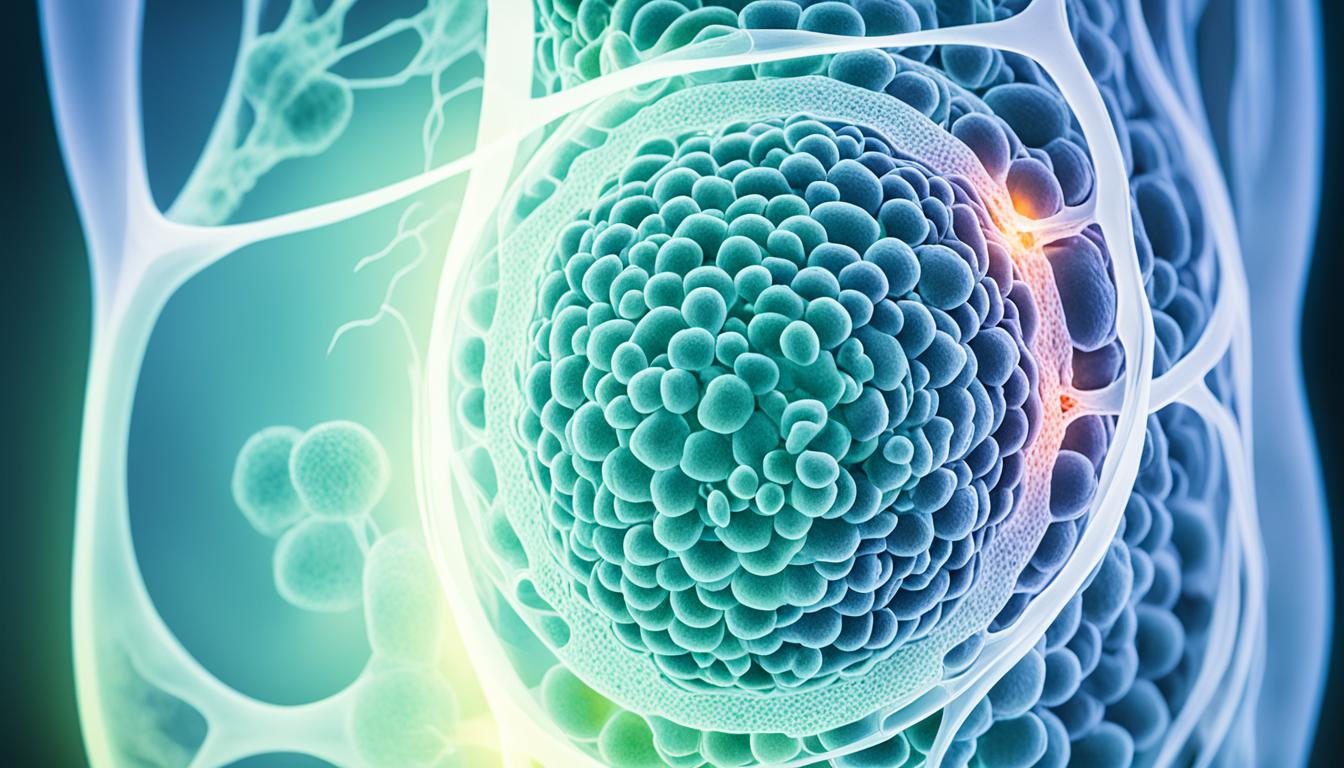Diverticulitis is when one or more of these small pouches get inflamed. You feel pain in the lower left belly and may also have diarrhea, fever, and chills. Some think it comes from not eating enough fiber, getting older, being overweight, or smoking.
Doctors check you out and run tests like blood work and imaging tests to know if it’s diverticulitis. There’s also research going on about using stem cells to treat this condition.
Key Takeaways:
- Diverticulitis causes pain, mainly in the lower left stomach.
- Its signs are diarrhea, fever, and chills.
- Not eating enough fiber, getting older, being overweight, or smoking may cause it.
- Diagnosis needs a physical exam, checking your health history, and tests.
- There’s a look into using stem cells to treat it.
Symptoms and Complications of Diverticulitis
Diverticulitis is a problem where there is inflammation in certain parts of the colon. It comes with many symptoms and can cause serious issues. It is key to know these symptoms for quick diagnosis and treatment. Also, being aware of possible complications can guide people to get help when necessary.
Diverticulitis Symptoms
The first sign of diverticulitis is usually a sharp pain in the lower left side of the belly. This pain might be sometimes or all the time and can change in how bad it is. It’s easy to confuse this pain with other stomach problems. So, careful diagnosis is really important.
Other signs can include a change in how often you go to the bathroom. Some may find themselves constipated, others have diarrhea, and some switch back and forth. Feeling swollen in the stomach area is common. Also, seeing blood in the stool can happen with diverticulitis.
Diverticulitis Complications
Diverticulitis can lead to severe problems that need quick medical care. For example, peritonitis can occur, which means an infection inside the belly. Stopping this infection from spreading is very important.
Another complication is when bleeding happens in the stomach. This can take place if one of those pouches in the intestines starts to bleed. A blockage in the intestines, called a bowel obstruction, can also show up. This can be a dangerous scenario.
Yet another issue to watch out for is abscesses. These are swollen, pus-filled pockets that can cause a lot of pain. Sometimes they need to be drained by doctors or even require surgery.
One more thing that can happen is the creation of a fistula. A fistula is an unusual tunnel between different body parts. It’s common for these to happen between the colon and other organs. Depending on where and how bad they are, they can cause a lot of trouble.
It’s crucial for those with diverticulitis to know about these risks and to get help if they start feeling worse or get new symptoms. Quick treatment can stop further issues and lead to better health outcomes.
Keep reading for more on the causes and how to prevent diverticulitis.
Causes and Prevention of Diverticulitis
Diverticulitis is a condition where the colon’s pouches become inflamed. Doctors aren’t sure exactly why this happens but know a few things that might cause it.
A main cause of diverticulitis is not eating enough fiber. A diet lacking in fiber can cause constipation. This, in turn, raises pressure inside the colon. This can lead to the growth of the pouches.
Diet isn’t the only thing that matters. Being too heavy or smoking can also up your chances. Extra weight can add stress to your colon. Smoking can make your gut more prone to inflammation.
To lower your risk, changing what you eat is key. A high-fiber diet is a good start. This means eating lots of plants and whole grains. Fiber keeps things moving in your gut smoothly and prevents hard stools.
Drinking enough water is just as important. Staying hydrated helps you avoid constipation. It’s also key to keep active and watch your weight.
Diagnosis and Treatment of Diverticulitis
The diagnosis of diverticulitis requires a close look at your health. Doctors will do a physical exam and talk about any past illnesses. They might also use blood tests, check your stool, and take images. These steps are key to figuring out if you have diverticulitis or something else.
After knowing it’s diverticulitis, the treatment plan depends on how bad it is. For the mild cases, changing your diet can be enough. A diet full of fiber can keep your gut healthy and lower the chance of problems. You might need antibiotics for infections. Pain meds will also help make you feel better.
Sometimes, if things are pretty bad, you may need surgery. This is for issues like big infections, tunnels between parts of your gut, or a blockage. The goal of surgery is to fix these problems. It can cut down on how often you get sick and make you feel better.
Doctors are also looking into new ways to treat diverticulitis, like using stem cells. Stem cells can help repair damaged tissues. This could be great news for people who don’t do well with regular treatments. Even though this option is still new, it could change how we deal with diverticulitis in the future.

